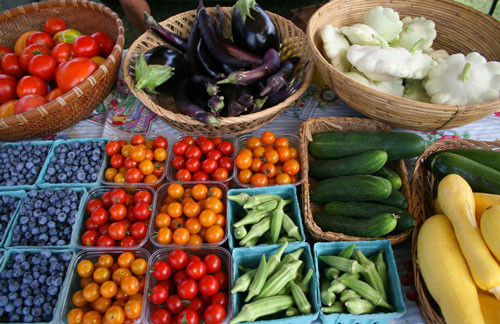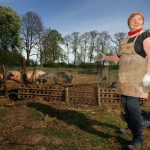
As spring arrives and we begin stopping by our farmers’ markets and roadside stands for the early local harvest, it’s a good time to revisit how community engagement is both limiting and expanding efforts to build stronger regional food systems. I will focus on an obvious – but all too often missing – link in engagement efforts: local farmers.
There’s a lot of information out there about how to engage the community in farm and food initiatives, even on my own organization’s web site: best practices for supporting farmers’ markets, the impact of CSA (community-supported agriculture) purchases, strategies for involving youth in the local agriculture arena, and building strong networks of diverse stakeholders. These efforts have raised the level of awareness about local food in many useful and relevant ways, increasing our communities’ participation in and understanding of the importance of regional agriculture.
But there’s one thing that we hardly ever see, and that’s the flipside of the local food movement’s engagement strategies: how do we make sure that the farmers who actually grow the food are being heard in these discussions?
All too often, decisions are made by diverse groups of stakeholders, but with little or no farmer representation. This can lead to expensive mistakes – such as grant-funded community kitchens that are hardly ever used – as well as to increased distrust between farmers and the government, nonprofit, and educational agencies that aim to support them.
It’s a problem we see in many communities – both urban and rural – as North Carolina struggles to keep its top industry healthy and sustainable. Agriculture brings in over $78 billion to the state’s economy, employs 16% of the workforce, and is one of the most diversified farming states in the nation due to its three unique climate areas of the mountains, Piedmont, and coastal regions.

Using the same strategies for engagement with farmers that we use to engage the community is simply not a good solution, and unfortunately, we haven’t found many better options yet.
There are multiple reasons for this. Farmers are, first and foremost, too busy to spend time sitting in meeting rooms, providing information in focus groups, or attending online webinars. It takes a lot of work to grow the food that we’re so focused on getting into our local markets.
That workload means that the people whose input we need are working from sunup to sundown every day, and that for much of the year – when it’s warm enough to plant or to harvest – they’re going to be unable to participate. That leaves a window of only a few winter months each year in which they have the spare time to participate in planning efforts.
Farmers are also often reluctant to participate in these efforts. Their vocation aligns with enjoying solitude, the absolute lack of the need to wear a tie, or the happy distance from the hustle and bustle of the office environments in which they’re usually asked to meet. Local food meetings are usually held in urban areas, requiring farmers to travel (sometimes for very long distances).
Some groups have tried to utilize online media as a way to remove the travel and meeting burden – but again, that comes from a generally poor assumption. Many farmers don’t have or use computers often, and many of North Carolina’s rural areas don’t have access to Internet at speeds that support these media-rich platforms.

Even worse, perhaps, are the occasions when those meetings are marketed in a way that disengages farmers from the beginning. Although it takes many components to build a successful food system, framing meetings around “what we need from farmers” (like more farmers’ markets to increase healthy food access, which they may not have time to participate in) isn’t a great way to start that conversation. Engagement begins with meeting people where they are – and in this case, with a focus on “what we can do for farmers” (training on new food handling regulations, for example, that doesn’t come with a heavy-handed, complex, or negative approach).
The local food movement in North Carolina is enjoying strong momentum right now, and many admirable efforts are underway to build better supply chains, support farmers with knowledge and training, and enable farmers to enter new markets. But with the swiftly changing federal and state regulatory environment, the fact that nearly 35% of all farming families are eligible for SNAP benefits because they make so little, and the increasing need for local product that this movement has produced, it’s more important than ever that we begin to get creative in engaging the farmers in this conversation.
Besides, working with farmers in a productive and engaging way might be the prettiest and tastiest trip we’ll ever make when we talk about “meeting people where they are.”
I love this post, Emily, because it gets to what I see as a basic challenge to government – assumption! Your example of building a community kitchen, for example, that is underused. In a case like that, I would wonder if all the stakeholders who were assumed to need the kitchen were included in part of the process in forming the grant application… In my work I am finding that we often don’t check our assumptions or gather enough information before decision-making. For example, with some federal food assistance programs I am working with, the federal program assumes local non-profits have the capacity to forward fund major food purchases to provide summer meals and then be able to wait several months for reimbursements. This level of financial stability may be true of some local non-profits, but not of others. Yet we wonder why small non-profits in rural areas don’t participate in the program as much as we would like. Communication, checking assumptions, engaging those necessary to the success of the project in the actual design of the project are key.
As a former farm girl, I very much appreciate your post Emily. One “meeting” space that was important to us growing up on a farm was 4H. We learned a lot in 4H about farming but I’m having trouble remembering whether there were programs on community building, leadership, civic skills, etc. Does anyone know whether that has changed? The work that I do on the civic education of young people suggests that early experiential learning of civic skills is important.
Katy, thanks for making the connection to 4-H. 4-H is very involved in teaching our youth leadership, citizenship and life skills. We are committed to helping grow citizen leaders who are leaders in their communities, country, and world. All of our programming is based around the experiential learning model and we hope through the work done across the state (and nation), we are helping to produce a generation of civically minded and engaged young people. Feel free to reach out if we can be of assistance!
It’s actually a nice and helpful piece of info.
I’m happy that you simply shared this helpful info with us.
Please keep us up to date like this. Thanks for sharing.